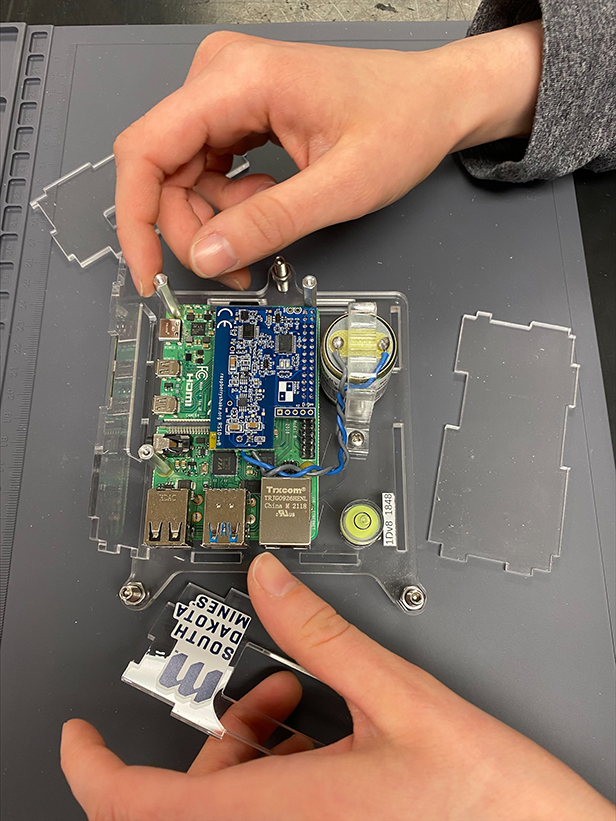Elise Staat, a senior geology student at South Dakota Mines, and her advisor, Kevin Ward, Ph.D., assistant professor of geology and geological
engineering at Mines, may have found a relatively inexpensive way to measure
the thickness of the Earth’s crust using seismic waves.
The Earth is in constant motion, and plate tectonics
and volcanism produce a continuous hum of earthquakes around the planet every
hour of every day. The nature of these vibrations can allow researchers to
better understand the deeper parts of the Earth itself, including the depth of
the crust.
Traditionally, seismometers, which are the devices
that measure earthquakes, are complex, expensive and sensitive scientific
instruments that are located in specially made bunkers in remote locations
where they can monitor the rumblings of the Earth.
As these rumblings travel though the Earth, slight
variations in the Earth’s subsurface changes how instruments will record the radiated
seismic energy. These slight variations can be used to understand how the
structure of the Earth looks at depths no human can ever access or see, dozens
to hundreds of miles below our feet.
 Staat’s unique project involves a small affordable consumer
grade seismometer, called a Raspberry Shake, deployed in the Sanford
Underground Research Facility (SURF) at 4100 feet
below the surface of Lead, SD. The study tested the sensitivity of the device
for use in calculating the depth of the Earth’s crust when compared to a research
grade seismometer located on the eastern slope of the Black Hills. The
Raspberry Shake has not previously been fully tested for its accuracy in measuring
the thickness of the crust when compared to more expensive conventional
seismometers.
Staat’s unique project involves a small affordable consumer
grade seismometer, called a Raspberry Shake, deployed in the Sanford
Underground Research Facility (SURF) at 4100 feet
below the surface of Lead, SD. The study tested the sensitivity of the device
for use in calculating the depth of the Earth’s crust when compared to a research
grade seismometer located on the eastern slope of the Black Hills. The
Raspberry Shake has not previously been fully tested for its accuracy in measuring
the thickness of the crust when compared to more expensive conventional
seismometers.
“It’s a more affordable way to do this kind of
research,” says Staat. “This is curiosity driven science; we’re deploying this
smaller less expensive instrument to see what we find,” adds Ward.
Staat cross checked earthquake data from both the
research grade and consumer grade instruments and was surprised by the results.
“The Raspberry Shake did indeed perform in similar
accuracy as the broadband station,” she says.
Staat examined data from 6.5 magnitude earthquake that
struck Peru midmorning on Feb. 3, 2022. The seismic waves from this event arrived
nearly simultaneously on both devices in the Black Hills. The average depth
of the crust in the Black Hills is believed to be around 42 km. Staat used the data
to independently calculate the depth of the crust with both instruments. The Raspberry
shake showed a depth that was within 7% of the research grade seismometer. This
difference is within the margin of error and may also reflect the different
locations of the two instruments, separated by about 20 miles. The Raspberry
Shake, located deep inside SURF, was also about one mile deeper than the research
grade seismometer located on the surface.
“In general, we know how thick the crust is below
the Black Hills. Getting another measurement is not the exciting thing here.
What is exciting is how the measurement was made, with a relatively inexpensive
and small instrument. So, imagine what new discoveries could be made with a
million of these things on Earth, or a thousand on Mars, or some other solar
system body. This is one exciting direction modern seismology is heading,” Ward
says.
Ward and Staat envision further research that could
incorporate more data and analysis to increase the accuracy of the comparison
of the two devices. There are currently more than 1,600 Raspberry Shakes in
operation, sharing open-source data from around the planet.
If the Raspberry Shake proves successful at
capturing data needed for measurements of the depth of the crust, it could open
a door to a new branch of affordable citizen science that could measure various
other properties of the unseen Earth at different locations.
The research is continuing, and Ward is hoping to
deploy more Raspberry Shake Seismometers in areas around the Black Hills that
can be used by Staat and future students in new studies that extend this work.
The team is looking for volunteers who are willing to host these small
seismometers in their basements or crawlspaces in homes or cabins in the area.
This network could extend understanding of seismic activity in the Black Hills and
possibility lend new insight to the subsurface of the Earth.